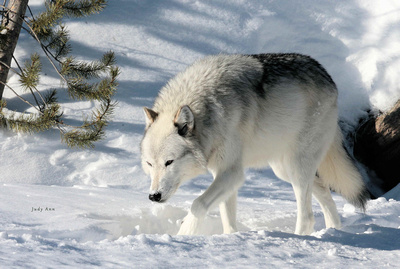

Have you ever smiled at the antics of apes because you recognized their capers as remarkably similar to our own? The same is true with wolves and domestic dogs. A chance meeting with grey wolves, precipitated by a snowstorm which stranded me in Yellowstone Park, opened a splendid window for observation and education about our domestic dogs' wild cousin. All dogs from Chihuahas to St. Bernards and everything in between descend from wolves; specifically from the grey wolf. There are 34 species in the Canidae family including domestic dogs, wolves, foxes, coyotes, and jackals. After a long absence from Yellowstone Park, a group of eight Jasper, Alberta wolves were transported and reintroduced in 1995, and the park classroom has been in session ever since. As of January 2020, there are at least 94 wolves in Yellowstone park. Eight packs have been recorded, and the population since 2009 has fluctuated between 83 and 108. In the following images, I have included much of what I learned from park rangers and biologists about this fascinating canine, also known as canid. Enjoy.
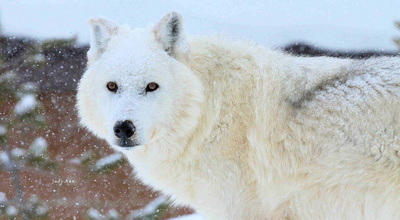

Love him or hate him, the cascade of change from the wolf’s presence continues to unfold. In the 1930s, the wolf was completely annihilated, and as a consequence, predatory pressure on elk populations was downgraded to the extent that elk pushed the limits of carrying capacity. Elk ceased to migrate for winter foraging, instead desecrating the willow, aspen and cottonwood stands that beaver needed to survive. Here’s what’s really intriguing. According to park officials, we have three times the number of elk than in 1968 when there were no wolves and yet, willow and other trees are thriving. Why? Because wolves keep the elk on the move. Beaver are synonymous with stream hydrology, and because they now have a robust food source that was once crippled by non-moving elk, the dams they build help flatten the curve of those damaging pulses of seasonal runoff. Not only that, they aid in recharging the water table, provide more shading and cooler water temperatures for fish, and songbirds benefit from the fortified habitat.
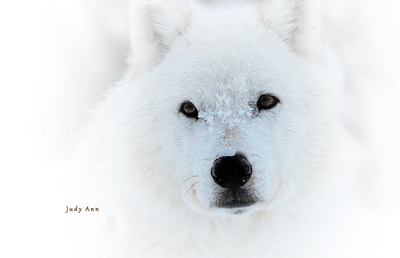
 Which dogs are most closely related to wolves? Not surprisingly, two are the Akita and the Alaskan Malamute. The question arises, how many times were dogs domesticated from wolves? One theory from a 4,700 year old wolf skull strongly suggests that it happened only once, and from a single group of wolves.
Which dogs are most closely related to wolves? Not surprisingly, two are the Akita and the Alaskan Malamute. The question arises, how many times were dogs domesticated from wolves? One theory from a 4,700 year old wolf skull strongly suggests that it happened only once, and from a single group of wolves.


DNA studies are continuing to reveal so much about these animals. The first large study of North American wolf genomes revealed there is only one species on the continent: the grey wolf. Two other purported species, the Eastern wolf and the red wolf, are mixes of gray wolf and coyote DNA.
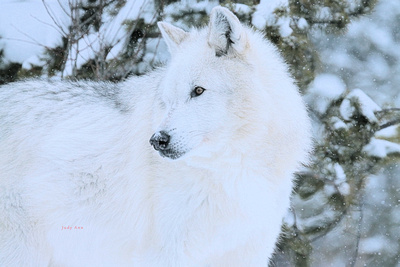
 So how did wolves become dogs? One theory is they were unintentionally domesticated after they began trailing ancient hunter-gatherers for scraps. The more docile wolves probably enjoyed extra treats, passing on their friendly genes over time and eventually became our beloved dogs.
So how did wolves become dogs? One theory is they were unintentionally domesticated after they began trailing ancient hunter-gatherers for scraps. The more docile wolves probably enjoyed extra treats, passing on their friendly genes over time and eventually became our beloved dogs.
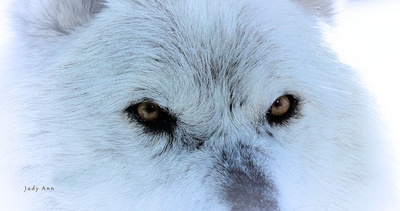
 Just how smart are they, you ask? A 2017 published study of Scientific Reports by an international team of researchers at the Wolf Science Center in Vienna, Austria concluded that wolves are smarter than dogs. Studies revealed that domesticated dogs cannot make the connection between cause and effect. Wolves, however, can. Remember the Jurassic Park scenes about the velociraptors? They remember…
Just how smart are they, you ask? A 2017 published study of Scientific Reports by an international team of researchers at the Wolf Science Center in Vienna, Austria concluded that wolves are smarter than dogs. Studies revealed that domesticated dogs cannot make the connection between cause and effect. Wolves, however, can. Remember the Jurassic Park scenes about the velociraptors? They remember…
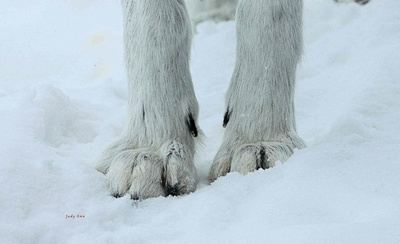

Wolves have very large feet in relation to body size compared to that of dogs. Wolves actually run on their toes which aids in those fast turns and prevents their paw pads from wearing down. They also have small webs between their toes which makes them excellent swimmers, paddling distances of up to eight miles.
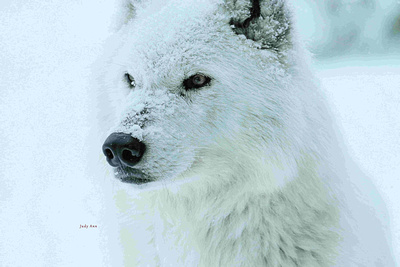

Dogs and wolves share 98.8% of the same DNA. They readily interbreed but it is reported that the offspring are typically not fertile. Dogs and wolves of comparable size share a similar captivity lifespan of about 12-14 years.
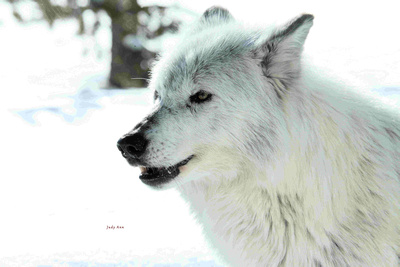

If you call, they will answer. Biologists find that wolves will regularly respond to humans imitating their calls. The International Wolf Center in Minnesota even sponsors “howl nights” where you can talk to the wolves.
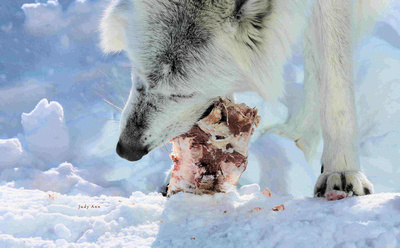
 A wolf's bite force is actually related to skull size; larger wolves have greater bite force. The average is 400 PSI; but biologists conclude that in defense mode, a wolf rivals a grizzly at 1200 PSI.
A wolf's bite force is actually related to skull size; larger wolves have greater bite force. The average is 400 PSI; but biologists conclude that in defense mode, a wolf rivals a grizzly at 1200 PSI.
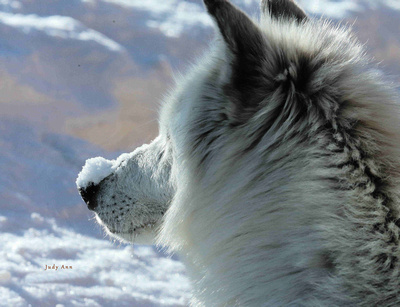
 We've all watched our dogs bury a favorite bone or toy and then dig it up later. That behavior is more than just play; its instinctive. It's a throwback to survival skills that the grey wolf still practices today.
We've all watched our dogs bury a favorite bone or toy and then dig it up later. That behavior is more than just play; its instinctive. It's a throwback to survival skills that the grey wolf still practices today.
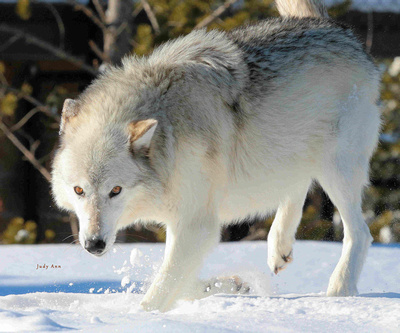
 Wolves have a variety of distinctive facial expressions for communication as well as for unifying the pack.
Wolves have a variety of distinctive facial expressions for communication as well as for unifying the pack.

 Since reintroduction, genetic studies have revealed much about the packs from health to kinship to behavioral traits. One of the most fascinating involves coat color. About half of Yellowstone’s wolves are black; the other half grey. This is just color; they’re still all grey wolves. Researchers have determined that black coats are due to a single beta defensin gene, CBD103 or K-locus. All black wolves carry a mutation linked to this black coat color and it is believed to have originated in domestic dogs. The origin of the K-locus likely occurred from hybridization between dogs and wolves in northwest North America in the last 7,000 years when humans brought domestic dogs across the Bering Land Bridge.
Since reintroduction, genetic studies have revealed much about the packs from health to kinship to behavioral traits. One of the most fascinating involves coat color. About half of Yellowstone’s wolves are black; the other half grey. This is just color; they’re still all grey wolves. Researchers have determined that black coats are due to a single beta defensin gene, CBD103 or K-locus. All black wolves carry a mutation linked to this black coat color and it is believed to have originated in domestic dogs. The origin of the K-locus likely occurred from hybridization between dogs and wolves in northwest North America in the last 7,000 years when humans brought domestic dogs across the Bering Land Bridge.
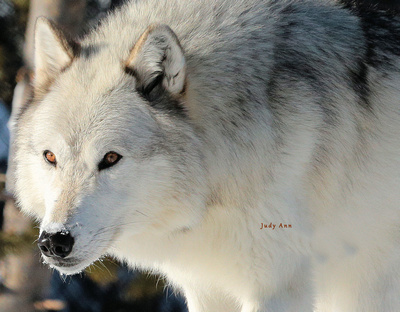
 Additional studies on links between coat color, reproduction, survival and behavior also revealed astounding details. The K-locus gene is involved in immune function, intimating pathogen defense. Black wolves have greater resistance to distemper outbreaks, but grey wolves are more aggressive and territorial.
Additional studies on links between coat color, reproduction, survival and behavior also revealed astounding details. The K-locus gene is involved in immune function, intimating pathogen defense. Black wolves have greater resistance to distemper outbreaks, but grey wolves are more aggressive and territorial.

 A fierce predator, you bet. But they warmed my heart as I watched them frolic in the snow just as our own dogs do.
A fierce predator, you bet. But they warmed my heart as I watched them frolic in the snow just as our own dogs do.